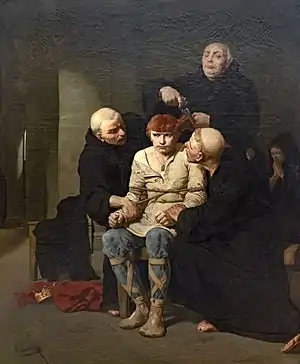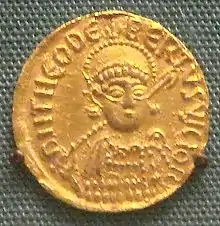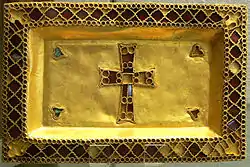Childeric III
Childeric III (c. 717 – c. 754) was King of Francia from 743 until he was deposed by Pope Zachary in March 751 at the instigation of Pepin the Short. Although his parentage is uncertain, he is considered the last Frankish king from the Merovingian dynasty. Once Childeric was deposed, Pepin the Short, who was the father of emperor Charlemagne, was crowned king, initiating the Carolingian dynasty.[2]
| Childeric III | |
|---|---|
| King of the Franks | |
| Reign | 743–751 |
| Predecessor | Theuderic IV |
| Successor | Pepin the Short |
| Born | about 717 |
| Died | about 754 |
| Issue | Theuderic |
| Dynasty | Merovingian |
| Father | ?Chilperic II or Theuderic IV[1] |
Background
Following the reign of Dagobert I (629–634), the power of the Merovingian kings gradually declined into a ceremonial role, while the real power in the Frankish kingdom was increasingly wielded by the mayors of the palace. In 718, Charles Martel combined the roles of mayor of the palace of Neustria and mayor of the palace of Austrasia, consolidating his position as the most powerful man in Francia. After the death of king Theuderic IV in 737, the throne remained vacant, and Charles Martel became de facto king.
After Charles Martel's death in 741, Carloman and Pepin the Short, his sons by his first wife Rotrude, became co-mayors of the palace. However, they soon faced revolts from their younger half-brother Grifo and their brother-in-law Odilo, Duke of Bavaria. These revolts may have played a part in their decision to fill the throne with a Merovingian king after a six-year vacancy to add legitimacy to their reigns.[3]
Life

Childeric's parentage and his relation to the Merovingian family are uncertain. He may have been either the son of Chilperic II or Theuderic IV.[1]
According to Einhard, Charlemagne's biographer, Childeric took little part in public business and would, once a year, be brought in an ox cart led by a peasant and preside at court on a throne, giving answers prepared by the mayors to visiting ambassadors.[4] In this narrative, he had neither political or economic power, depending on his own small estate and on mayoral support.[4]
After Carloman retired to a monastery in 747, Pepin resolved to take the royal crown for himself. Pepin sent letters to Pope Zachary, asking whether the title of king belonged to the one who had exercised the power or the one with the royal lineage. The pope responded that the real power should have the royal title as well. In early March 751 Childeric was dethroned by Pope Zachary and tonsured.[5] His long hair was the symbol of his dynasty and thus the royal rights or magical powers; by cutting it, they divested him of all royal prerogatives. Once dethroned, he and his son Theuderic were placed in the monastery of Saint-Bertin[6] or in Saint-Omer and Theuderic in Saint-Wandrille.
There are conflicts in information of when he exactly died with some references citing as early as 753 and other references saying it was as late as 758. Under the Carolingians, he received bad press, being called a rex falsus, false king, despite the fact that it was Pepin through Popes Zachary and Stephen II who raised him to his throne.
References
- Rosenwein 2009, p. 84.
- Riché 1993, p. 65.
- McKitterick 1999, p. 34.
- Frassetto 2003, p. 118.
- Tierney 2004, p. 20.
- Theuws, de Jong & Van Rhijn 2001, p. 326.
Sources
- Barnwell, P. S. (2005). "Einhard, Louis the Pious and Childeric III". Historical Research. 78 (200): 129–39. doi:10.1111/j.1468-2281.2005.00224.x.
- Bouchard, Constance B. (2013). "Childeric III and the Emperors Drogo Magnus and Pippin the Pious". Medieval Prosopography. 28: 1–16.
- De Jong, Mayke (2001). "Monastic Prisoners or Opting Out? Political Coercion and Honour in the Frankish Kingdoms". In Frans Theuws; Mayke de Jong; Carine Van Rhijn (eds.). Topographies of Power in the Early Middle Ages. Brill. pp. 291–327.
- Enright, Michael (1985). Iona, Tara, and Soissons: The Origin of the Royal Anointing Ritual. Walter de Gruyter.
- Fouracre, Paul (2005). "The Long Shadow of the Merovingians". In Joanna Story (ed.). Charlemagne: Empire and Society. Manchester University Press. pp. 5–21.
- Frassetto, Michael, ed. (2003). "Childeric III (d.754)". Encyclopedia of Barbarian Europe: Society in Transformation. ABC-CLIO. pp. 118–19.
- Geary, Patrick J. (1988). Before France and Germany: The Creation and Transformation of the Merovingian World. Oxford: Oxford University Press.
- McKitterick, Rosamond (1999). The Frankish Kingdoms under the Carolingians. Longman.
- Riché, Pierre (1993). The Carolingians: A Family Who Forged Europe. Translated by Allen, Michael Idomir. University of Pennsylvania Press.
- Rosenwein, Barbara H. (2009). A Short History of the Middle Ages. University of Toronto.
- Tierney, Brian (2004). The Crisis of Church and State, 1050-1300. University of Toronto Press.
- Wood, Ian N. (1994). The Merovingian Kingdoms, 450–751. Harlow: Longman.
Further reading
| Wikimedia Commons has media related to Childeric III. |
| Wikisource has the text of the 1911 Encyclopædia Britannica article Childeric. |
- Junghans, W. Die Geschichte der fränkischen Konige Childerich und Clodovech. Göttingen, 1857.
- Chiflet, J. J., Anastasis Childerici I Francorum regis. Antwerp, 1655.
- Cochet, J. B. D. Le Tombeau de Childeric I, roi des Francs. Paris, 1859.
- Lavisse, E. Histoire de France, Vol. II. Paris, 1903.
- Wallace-Hadrill, J. M., translator. The Fourth Book of the Chronicle of Fredegar with its Continuations. Greenwood Press: Connecticut, 1960.
- Wallace-Hadrill, J. M. The Long-Haired Kings. London, 1962.
- Einhard. Annales Regni Francorum.
| Vacant Title last held by Theuderic IV |
King of the Franks 743–751 |
Succeeded by Pepin |

